31 October 2020
This is one of the plant IDs I posted in 2013 and removed a few days later (I mention this as a courtesy to those who saw it in 2013 and wondered where it went). I am reposting it as it was originally, but I have updated a couple of images and added captions to the new images.
Plant 93v—The Plant with Yam-like Roots
Plant 93v almost fully inhabits the folio, from top to bottom and more than half of the width on the right side of the folio. It is bold, with emphasis on each of its major parts, seeds, leaves, and roots. The text covers the top third and wraps through the stalks of the plant.
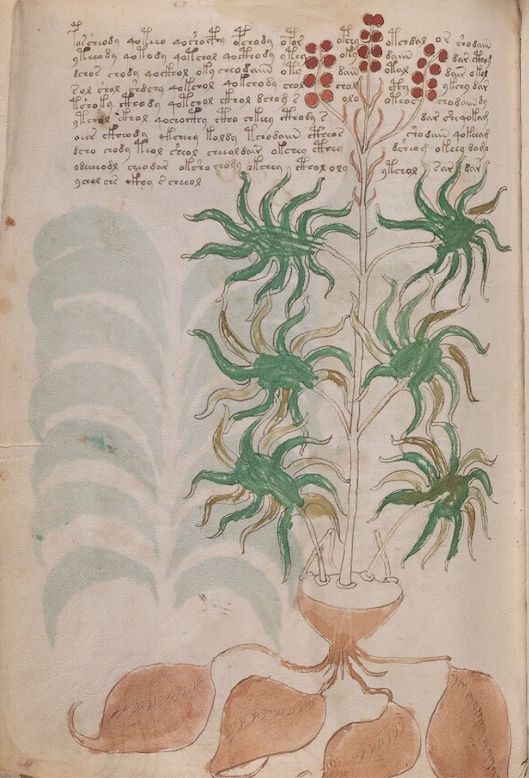
Outreau Leaves and Stalk
The leaves are distinctive and almost insect-like, but there are many plants with digitate leaves, so the leaves are not necessarily symbolic. They may be somewhat stylized. Some of the extensions are painted a browner shade of green. They are arranged opposite on a tall central stalk. There are slender bracts near the top where the stalk branches into flower- and seedheads. The stalk is mostly unpainted except for the reddish-brown bracts near the top.
buy gabapentin online canada Seeds
The rows of round red knobs might represent flowers, but I am inclined to interpret them as seeds, since they are similar to seeds on many plants and less similar to flowers. This arrangement of rows of flowers or seeds at the apex is common.
Prior IDs
I don’t agree with many of Edith Sherwood’s plant IDs, but her ID for 93v is reasonable. I do, however, think there is a better ID, but let’s discuss hers first. Sherwood has identified f93v as Lupine.
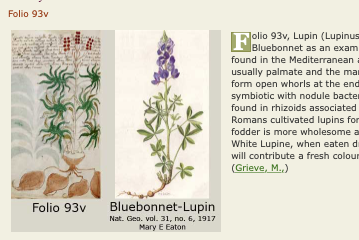
Lupine has an upright stalk, and leaves that might inspire a stylized interpretation like the leaves in the VMS. The flowers are at the top of the stalk. The roots are knobby, but the knobs tend to be swollen parts of a tap root rather than separate yam-like extensions, and they are not especially large. They are more similar to the roots of dock (Rumex). Thus, Lupine matches fairly well on three counts, but the roots are not a great match.
Other IDs
There is another plant with an upright stalk, deeply serrated leaves and a row of seeds at the top that has roots very similar to Plant 93v. It is commonly found in medieval herbals. This is my first choice for the VMS ID…
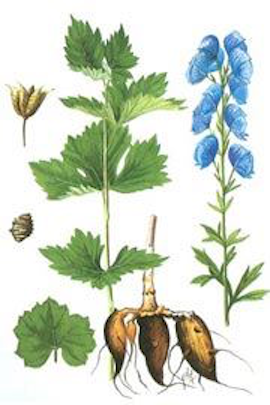
I think Plant 93v might be Aconitum, also known as monkshood. The roots are quite distinctive. They are yamlike, with long thin extensions at the end of the swollen part, and a small ‘bridge’ between each of the big knobs and the main stalk. This botanical drawing (left) illustrates the distinctive roots.
The various species of Aconitum that are common in Eurasia often have deeply serrated palmate leaves. The flowers are usually blue, burgundy, white, or whitish-yellow. Like lupine, the seeds are somewhat clawlike.
The multiple roots are sometimes like fat carrots, sometimes like yams.
Here is a species with more deeply serrated leaves:
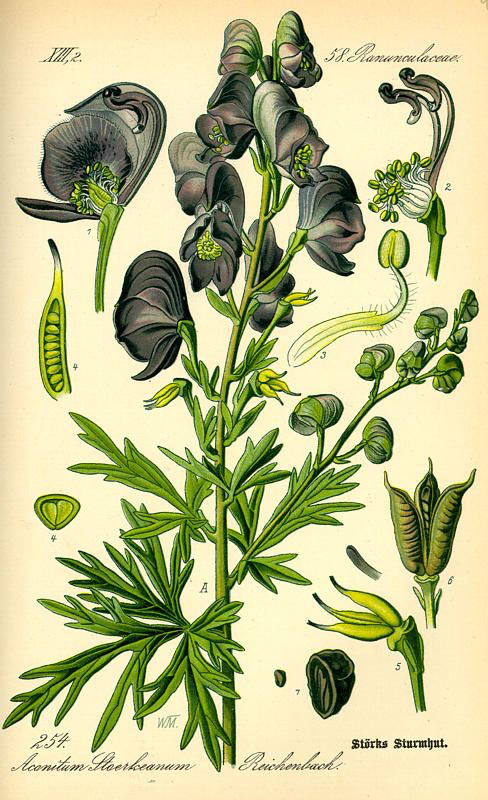
In medieval herbals, monkshood was often called, Aconitum, Napellus, Mapellus, Napello, or Napelen. It is a toxic herb that was used in medicinal recipes.
Sometimes it was drawn with a single root (like a fat carrot), sometimes with multiple roots. Here are two examples, one from a 15th-century herbal, another from a later herbal from the Pemberton Collection that represent the roots in similar ways:
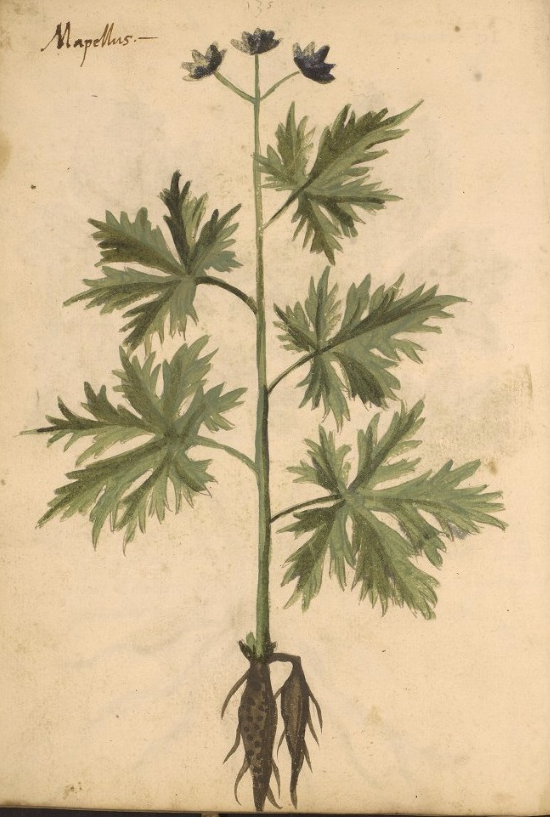
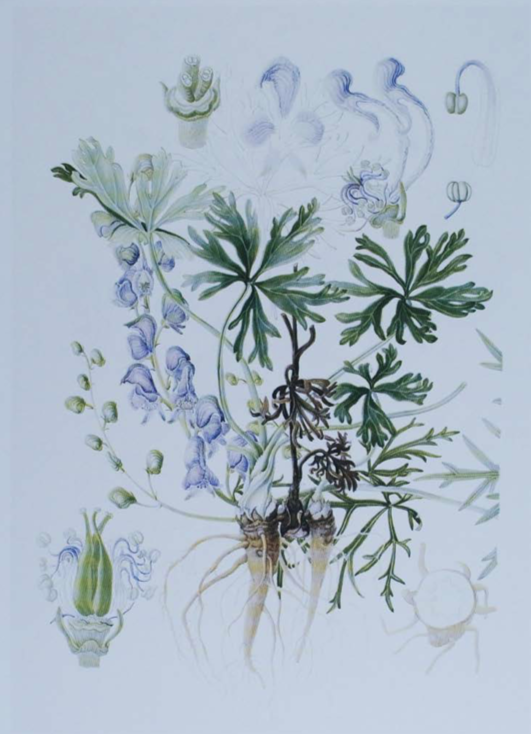
Both the above examples show two roots. What about multiple roots like the VMS? Those exist as well, as in this very early drawing from a Greek copy of Dioscorides:
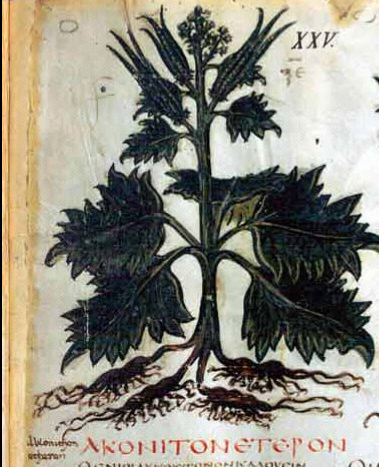
Most of the VMS plants can be matched up with several plants, but the roots of plant 93v are distinctive and when combined with the leaves and seeds, only match a few.
Less Convincing IDs
In addition to Aconitum, I considered Delphinium, a Eurasian plant also called larkspur. It has palmate, deeply serrated leaves, a central stalk with flowers at the top, and roots that look like short small carrots which sometimes clump. It differs from the VMS drawing in that the roots do not have the distinctive narrow bridges that connect them.
Oxalis lasiandra has digitate leaves and knobby roots, but it lacks the bridge between roots and does not have the distinctively upright stalk.
Some forms of geranium have deeply serrated leaves, but the stalks tend to be less upright, and the rhizome is simpler and less swollen than the VMS drawing.
Lupine is, of course, a possibility but, as mentioned above, it does not have the yamlike bridged roots of Aconitum and the VMS plant.
Summary
My top ID for Plant 93v is Aconitum, but it should be mentioned that Plant 96r has similar characteristics. The leaves are digitate, the roots somewhat yamlike, numerous, and somewhat bridged. I don’t have a naturalistic explanation for the flower or seedhead, but perhaps it is mnemonic:
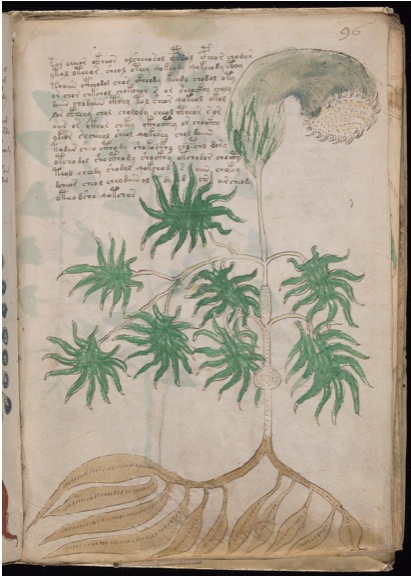
It’s hard to interpret the seed/flowerhead, but there are several species of monkshood, and medieval herbals sometimes included more than one.
Is it possible this represents another species of Aconitum and the somewhat stylized thickened drooping head represents a monk’s hood as a mnemonic for the plant name? If so, then the VMS follows a tradition of including more than one species of Aconitum, possible evidence connecting it to herbal customs of the time.
If it’s not another species of Aconitum, perhaps it is something like Arum vulgaris, voodoo lily, the form with long narrow leaves and swollen stems:
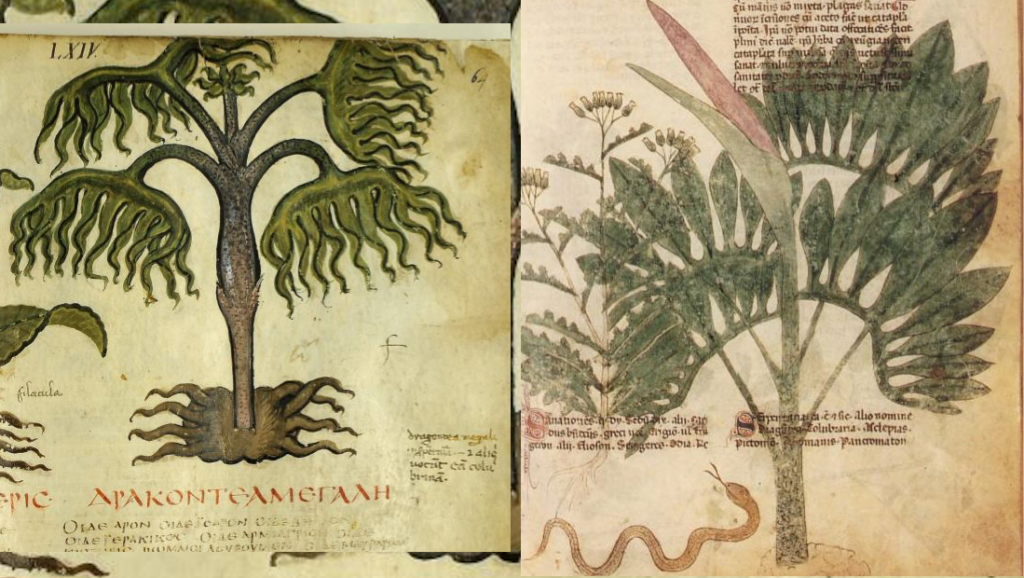
I am not certain if 93v and 96r are connected in terms of species, but they have several traits in common, so they might belong in the same plant family.
J.K. Petersen
© Copyright July 2013 and October 2020, J.K. Petersen, All Rights Reserved
